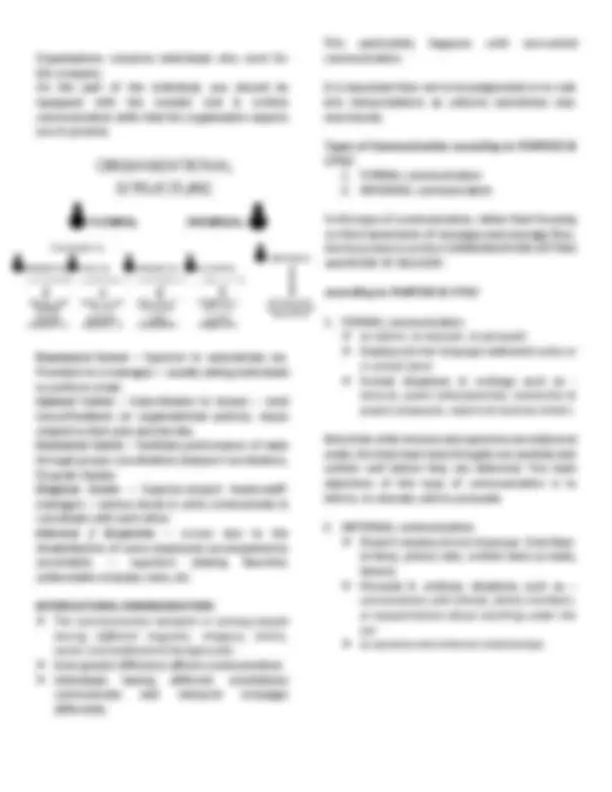



Study with the several resources on Docsity

Earn points by helping other students or get them with a premium plan


Prepare for your exams
Study with the several resources on Docsity

Earn points to download
Earn points by helping other students or get them with a premium plan
Community
Ask the community for help and clear up your study doubts
Discover the best universities in your country according to Docsity users
Free resources
Download our free guides on studying techniques, anxiety management strategies, and thesis advice from Docsity tutors
Reviewer about nature of language, types of communication and communication models.
Typology: Lecture notes
1 / 3

This page cannot be seen from the preview
Don't miss anything!



On special offer
Generally defined as the exchange of thoughts, ideas, concepts, and views between two or more people, various contexts come into play
C O N T E X T It is the circumstance or environment in which communication takes place.
C O N T E X T
Communication may be classified according to
Different contexts can impact one’s communication. Each communication type is governed by a particular circumstance. Thus, it is essential to pay attention to the interplay of factors surrounding the context of communication which may be physical, cultural, social and psychological in nature.
Types of Communication according to MODE
A message may be conveyed with these types. Though communication is often thought of as verbal, the non-verbal mode is equally essential as it enhances one’s message.
Verbal-Non-Verbal Communication Effective communication calls for blending of these two types. Ex. Door-to-door salespersons who demonstrate product knowledge can only be effective if they know how to properly punctuate what they say with proper gestures and facial expressions.
Visual Communication Uses visuals to convey information and/or messages It can be achieved through digital mode or text.
It now occupies an important place in any work environment. How these symbols are interpreted is very crucial in visual communication. There are some instances when visual comm is classified under non-verbal communication (persuasive communication). Ex. Signs, symbols, emojis, infographics, photos, presentations, videos, etc.
Use Big Images To Show Your Ideas
Types of Communication according to CONTEXT
Reasons for Intrapersonal Comm:
Self-talk can be advantageous as it can enable you to practice what you ought to say in times when you lack the motivation and confidence to speak. As you respond to life’s challenges, you may also find yourself verbalizing your thoughts and feelings. It is then important to introspect, you are able to improve on your decisions in life and likewise enhance your self-worth as a person.
Interpersonal communication means an interactive exchange Also known as group communication
However, as interpersonal comm occurs, a transaction doesn’t necessarily take place since it can only be a simple interaction such as – greeting, getting to know a person, or ordinary conversations that happen between or among the interactants. This may occur in dyads or small groups also known as group communication.
A communication is interpersonal when --
Interpersonal – social relationships – characterized by less seriousness & formality Transactional - objective is to achieve something at the end of the conversation – more formal & profound
INTERPERSONAL COMMUNICATION
SPEAKER A: Hello! I’m KC Ramos. And you are?
SPEAKER B: Oh, I’m Miko Mendoza. Glad to meet you. How are you related to the debutante? SPEAKER A: She’s my cousin. Her mom and mine are sisters. How about you?
SPEAKER B: She was my high school classmate. I never met any of her cousins so it’s great to meet you now. SPEAKER A: Yes, same here. Nice meeting you too.
TRANSACTIONAL COMMUNICATION
SPEAKER A: Excuse me. Would you know how to get to the nearest mall?
SPEAKER B: Yes. In fact you may go there on foot or take a jeepney. It’s a 20 minute walk. Just turn left then
straight ahead. Jeepneys take the same route and it shouldn’t take you more than 10 minutes even with the traffic. SPEAKER A: Thank you very much. I think I will just take the public transport as I am running out of time. You’ve been really helpful.
A communication is extended when -- It involves the use of electronic media. Messages are transmitted quickly.
Ex. Television, radio, expanded to --- tele, audio or phone conferencing; Video conferencing; skype calls; E-conferencing (Webinars) – participants may not be physically present but are still able to track down the lectures and actively participate actively because of mass articulation and dissemination of information, allowing speakers to reach a wider group of listeners (ex. MOOC, Coursera)
It is public in nature. Language used may be more formal. Your own thinking, behavior, and attitude may be influenced by other people and you may be persuaded to take views you hear.
It is important that you weigh and assess them against those beliefs that you hold onto so don’t get easily swayed by other people’s convictions.
ORGANIZATIONAL COMMUNICATION The focus is on the role that communication plays in organizational contexts. For an organization to be successful, a system of communication should be put in place. A set of rules or standards for communication protocol should be made clear so that interaction patterns are established.